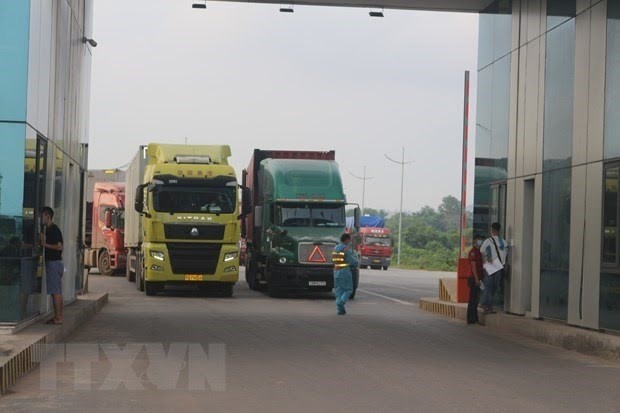Market orientation tweaked in face of Chinese barriers
 |
| Vehicles crossing Mong Cai border gate in Quang Ninh (Photo: VNA) |
In the last two years, the export of agricultural goods was met with many hindrances on its way to China, as the amount often exceeded the clearance capacity at the northern border gates and that country tightened its COVID-19 policy.
Li Keqiang, Premier of China, when talking by phone with Prime Minister Pham Minh Chinh on January 13, said that he had directed Chinese ministries and localities to solve this problem. At the same time, the Chinese premier proposed that the two sides would create more favourable conditions for Vietnamese agricultural products to be exported to China.
However, with China’s regulations in place to manage imported foreign food and related safety measures, Vietnam’s options to change the congestion of agricultural products at the border gates are limited.
Doan Thu Ha, Deputy Chairman of Lang Son People’s Committee, said, “We have proposed a suitable delivery plan to Guangxi’s authorities that could shorten clearance times. The Chinese side would need to recognise one-time tests and vaccinations of people, as well as establish a green zone for safe interactions.”
With these measures in place, Ha hopes that the border gate area can ensure smooth customs clearances. China is one of the largest markets of Vietnam’s agrifoods, so any change in policy will affect production and exports.
The Vietnamese government is making efforts to promote the transition from unofficial to official exports of agricultural products. However, because Chinese authorities were slow in agreeing on a suitable delivery plan, the country lost its position as the number one market for Vietnamese fruits and vegetables to the United States. For many years before this, China had been accounting for 65-80 per cent of the turnover of the industry.
Data from the Ministry of Agriculture and Rural Development shows that the value of Vietnamese fruit and vegetable exports to China decreased by nearly 19 per cent in the first two months of 2022 over the same period last year, reaching only $260 million.
China is no longer a convenient market as trade policies are geared towards official imports. Within the group of vegetables and fruits, China only allows the import of nine types of fruits from Vietnam – dragon fruit, watermelon, lychee, longan, banana, mango, jackfruit, rambutan, and mangosteen.
Another factor that further burdens current export activities comes from Vietnam’s weak infrastructure. Roads to the border gates have not been upgraded to keep up with the demand for bilateral trade. The railway connection between Vietnam and China through the two international railway gates Lao Cai-Ha Khau and Dong Dang-Bang Tuong also lacks optimisation, rendering this mode of transport unable to play its full role.
Vietnam is maintaining two forms of trade with China, including official trade according to international practice and small quotas through resident exchange and border markets.
Phan Van Chinh, director of the Import-Export Department under the Ministry of Industry and Trade, commented that Decree No.14/2018/ND-CP enacted in January 2018 detailing border trade activities has some priority points, but also reveals weaknesses that render export unstable. Enterprises could face difficulties coping with China’s imposed quality standards.
“Trade policy with China does not simply entail trade through official channels or open roads. It consists of developing export products in accordance with market standards and regulations, export organisation, and market issues. The transition to official practices is thus not a simple matter without thorough exchange between the parties,” Chinh said.
Small-scale exports may also remain one of the main causes of congestion at the northern border gates in the medium term. Vietnam has signed an agreement with China, lowering import tax for many agricultural products, but negotiations on goods’ quality management remain complicated and sluggish.
Last week, Minister of Agriculture and Rural Development Le Minh Hoan presided over the work to initiate a shift in exports of agricultural products from small to official quota. “We will gradually change from unofficial markets to official ones, exporting not only by road but also by rail, water, and air,” Minister Hoan said.
However, the minister said that it will take time to convert unofficial to official exports. “The development of this is urgent, but it is also necessary to look at Vietnam’s agricultural development and China’s market orientation for a suitable way forward,” he explained.
What the stars mean:
★ Poor ★ ★ Promising ★★★ Good ★★★★ Very good ★★★★★ Exceptional
Related Contents
Latest News
More News
- Vietnam’s industrial output hits seven-year high in 2025 (January 06, 2026 | 17:47)
- GELEX’s credit rating outlook upgraded to 'Positive' by VIS Rating (January 06, 2026 | 16:49)
- Finance sector lays firm groundwork for 2026 after major reform (January 06, 2026 | 15:30)
- Vietnam’s seafood exports surpass $11 billion in 2025 (January 06, 2026 | 08:51)
- Vietnam GDP posts second-strongest growth since 2011 (January 06, 2026 | 08:35)
- Double-digit GDP growth within reach with shift to higher-value expansion (January 06, 2026 | 08:33)
- Takeda Vietnam awarded for ongoing support of Vietnam’s sustainability efforts (December 31, 2025 | 21:00)
- Vietnam's retail market tops $269 billion in 2025 amid e-commerce boom (December 31, 2025 | 19:00)
- Stronger legal framework urged as trade fraud surges online (December 31, 2025 | 18:58)
- FPT exports first chip shipment to Japan (December 31, 2025 | 10:47)

 Tag:
Tag:


















 Mobile Version
Mobile Version